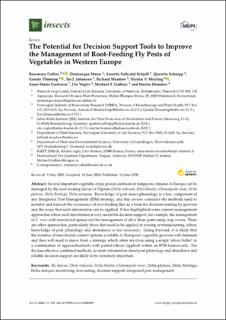The Potential for Decision Support Tools to Improve the Management of Root-Feeding Fly Pests of Vegetables in Western Europe
| dc.contributor.author | Collier, Rosemary | |
| dc.contributor.author | Mazzi, Dominique | |
| dc.contributor.author | Schjøll, Annette | |
| dc.contributor.author | Schorpp, Quentin | |
| dc.contributor.author | Thöming, Gunda | |
| dc.contributor.author | Johansen, Tor Jacob | |
| dc.contributor.author | Meadow, Richard | |
| dc.contributor.author | Meyling, Nicolai Vitt | |
| dc.contributor.author | Cortesero, Anne-Marie | |
| dc.contributor.author | Vogler, Ute | |
| dc.contributor.author | Gaffney, Michael T. | |
| dc.contributor.author | Hommes, Martin | |
| dc.date.accessioned | 2021-01-05T08:32:46Z | |
| dc.date.available | 2021-01-05T08:32:46Z | |
| dc.date.created | 2020-08-14T16:58:57Z | |
| dc.date.issued | 2020-06-13 | |
| dc.identifier.citation | Insects. 2020, 11 (6), . | en_US |
| dc.identifier.issn | 2075-4450 | |
| dc.identifier.uri | https://hdl.handle.net/11250/2721375 | |
| dc.description.abstract | Several important vegetable crops grown outdoors in temperate climates in Europe can be damaged by the root-feeding larvae of Diptera (Delia radicum, Delia floralis, Chamaepsila rosae, Delia platura, Delia florilega, Delia antiqua). Knowledge of pest insect phenology is a key component of any Integrated Pest Management (IPM) strategy, and this review considers the methods used to monitor and forecast the occurrence of root-feeding flies as a basis for decision-making by growers and the ways that such information can be applied. It has highlighted some current management approaches where such information is very useful for decision support, for example, the management of C. rosae with insecticidal sprays and the management of all of these pests using crop covers. There are other approaches, particularly those that need to be applied at sowing or transplanting, where knowledge of pest phenology and abundance is less necessary. Going forward, it is likely that the number of insecticidal control options available to European vegetable growers will diminish and they will need to move from a strategy which often involves using a single ‘silver bullet’ to a combination of approaches/tools with partial effects (applied within an IPM framework). For the less-effective, combined methods, accurate information about pest phenology and abundance and reliable decision support are likely to be extremely important. | en_US |
| dc.language.iso | eng | en_US |
| dc.publisher | MDPI, Basel, Switzerland | en_US |
| dc.rights | Navngivelse 4.0 Internasjonal | * |
| dc.rights.uri | http://creativecommons.org/licenses/by/4.0/deed.no | * |
| dc.title | The Potential for Decision Support Tools to Improve the Management of Root-Feeding Fly Pests of Vegetables in Western Europe | en_US |
| dc.type | Peer reviewed | en_US |
| dc.type | Journal article | en_US |
| dc.description.version | publishedVersion | en_US |
| dc.rights.holder | © 2020 by the authors | en_US |
| dc.source.pagenumber | 16 | en_US |
| dc.source.volume | 11 | en_US |
| dc.source.journal | Insects | en_US |
| dc.source.issue | 6 | en_US |
| dc.identifier.doi | 10.3390/insects11060369 | |
| dc.identifier.cristin | 1823418 | |
| dc.relation.project | Norges forskningsråd: 273179 | en_US |
| dc.source.articlenumber | 369 | en_US |
| cristin.ispublished | true | |
| cristin.fulltext | original | |
| cristin.qualitycode | 1 |
Tilhørende fil(er)
Denne innførselen finnes i følgende samling(er)
-
Divisjon for bioteknologi og plantehelse [523]
Publikasjoner knyttet til ansatte ved Divisjon for bioteknologi og plantehelse -
Publikasjoner fra CRIStin - NIBIO [4532]
-
Vitenskapelige artikler [1416]

